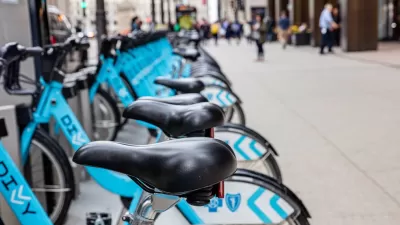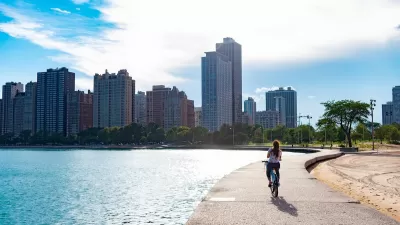Canadian researchers made the case at the Transportation Research Board this past week that improved bike infrastructure and neighborhood gentrification go hand in hand. They used research gathered fromi Portland and Chicago.
Researchers from the School of Urban Planning at McGill University and Université du Québec à Montréal "tried to quantify the connection between gentrification and cycling infrastructure," reports Emily Badger for Washington Post Wonkblog.
Cycling itself, as my colleague Perry Stein has written, has become a heated symbol of gentrification. Bike lanes are treated as harbingers of demographic change, or evidence of preferential treatment, or synonymous with well-off white men (all this, despite the fact that Census data shows low-income commuters are the most likely to bike).
["The people most likely to bike or walk to work are either the least educated in society or the most educated," wrote Badger on May 9, 2014 on the American Community Survey's findings.]
The researchers "mapped cycling infrastructure in Chicago and Portland alongside demographic change in neighborhoods between 1990 and 2010," writes Badger. "In both cities, they found "a bias towards increased cycling infrastructure in areas of privilege."
One sensitive issue was which comes first—the bike infrastructure or the changing demographics? Are new residents demanding bike infrastructure, or are wealthier, whiter, more educated residents attracted to bike-friendly neighborhoods? "The researchers sidestep the answer by suggesting that gentrification and cycling infrastructure 'mirror' each other in these two cities," writes Badger.
Check out the images mapping change in community composition, 1990-2010, showing cycling infrastructure in Chicago and Portland.
In Chicago, (n)eighborhoods with large white populations, or an influx of whites, were more likely to get these bike investments.
In both cities, denser neighborhoods closer to the center of town were more likely to have bike infrastructure.
Read how planners can address the pattern. To read the study, click here [25-page PDF].
Hat tip to Michael Keenly.
FULL STORY: Why bike lanes make people mad

Alabama: Trump Terminates Settlements for Black Communities Harmed By Raw Sewage
Trump deemed the landmark civil rights agreement “illegal DEI and environmental justice policy.”

Study: Maui’s Plan to Convert Vacation Rentals to Long-Term Housing Could Cause Nearly $1 Billion Economic Loss
The plan would reduce visitor accommodation by 25% resulting in 1,900 jobs lost.

Planetizen Federal Action Tracker
A weekly monitor of how Trump’s orders and actions are impacting planners and planning in America.

Wind Energy on the Rise Despite Federal Policy Reversal
The Trump administration is revoking federal support for renewable energy, but demand for new projects continues unabated.

Passengers Flock to Caltrain After Electrification
The new electric trains are running faster and more reliably, leading to strong ridership growth on the Bay Area rail system.

Texas Churches Rally Behind ‘Yes in God’s Back Yard’ Legislation
Religious leaders want the state to reduce zoning regulations to streamline leasing church-owned land to housing developers.
Urban Design for Planners 1: Software Tools
This six-course series explores essential urban design concepts using open source software and equips planners with the tools they need to participate fully in the urban design process.
Planning for Universal Design
Learn the tools for implementing Universal Design in planning regulations.
Caltrans
Smith Gee Studio
Institute for Housing and Urban Development Studies (IHS)
City of Grandview
Harvard GSD Executive Education
Toledo-Lucas County Plan Commissions
Salt Lake City
NYU Wagner Graduate School of Public Service




























